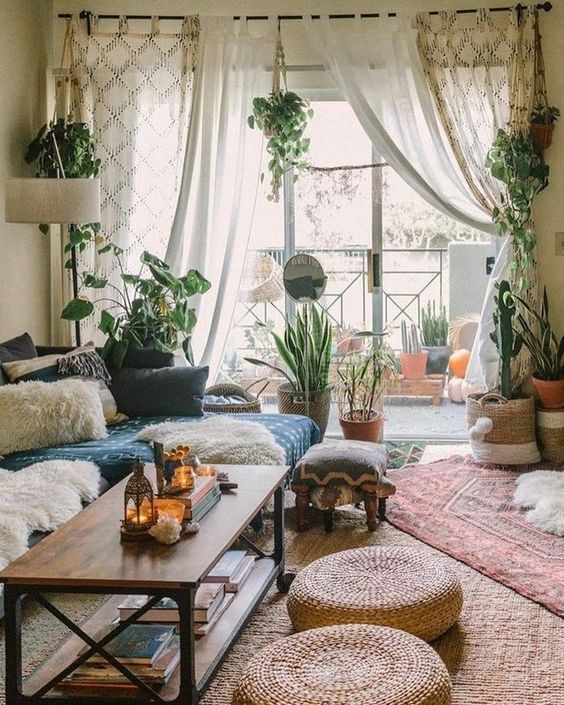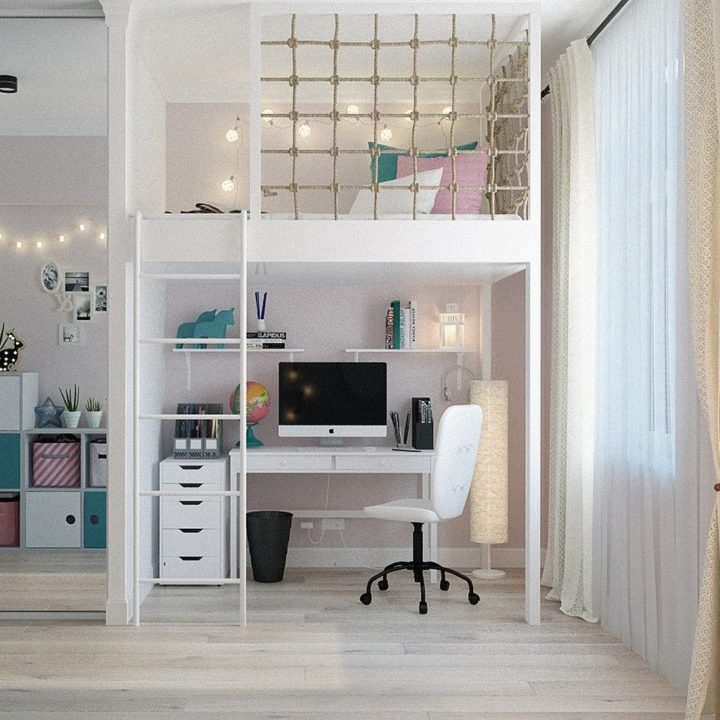Spiffy Speak
WINDOW TREATMENTS FOR PATIO DOORS: TOP IDEAS & TIPS
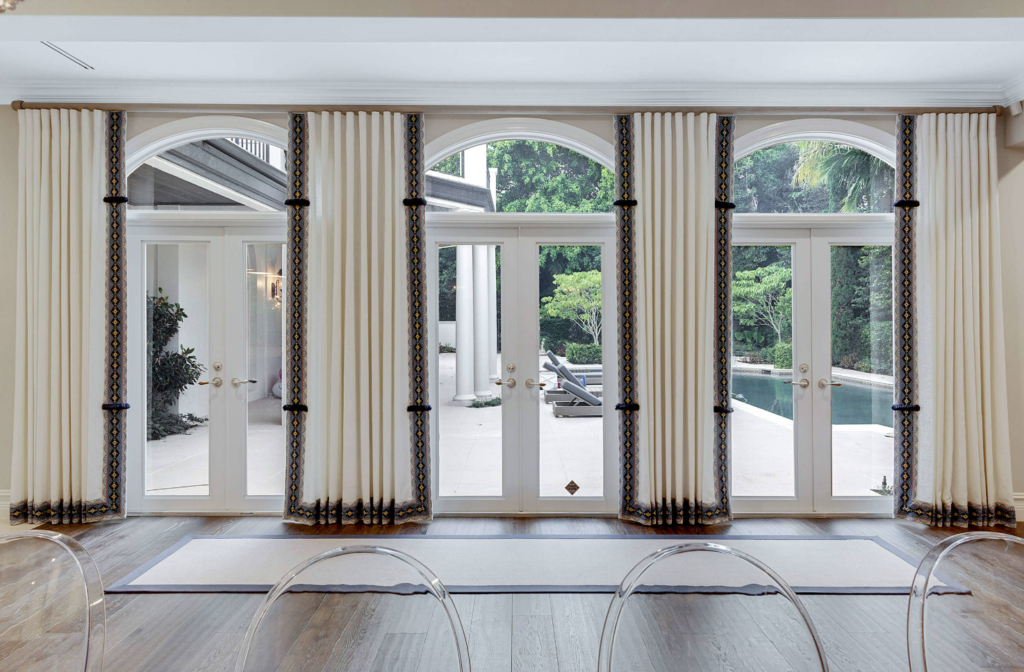
We all love our patios – be it for eventful barbeque nights or quiet ‘me-time’ with nature. With the onset of spring, our homes are refreshed with the summer resplendence spilling in. Thanks to glazed patio doors, we can enjoy warm natural light even as we nestle in our homes. But everything good comes with a price, and patio doors do compromise privacy and insulation. Thankfully, there are smart and chic window treatments that can offset the loss and also double up as decor accessories. If you’re looking for elegant and efficient window treatments for patio doors, find yourself in safe hands as we’re about to unveil all the secrets to get there.
Order custom window treatments from Spiffy Spools online in any size. We carry over 3,000 fabrics and patterns to pick from, so you can dress your patio doors exactly to your liking!
Window Treatments for Patio Doors: Key Considerations
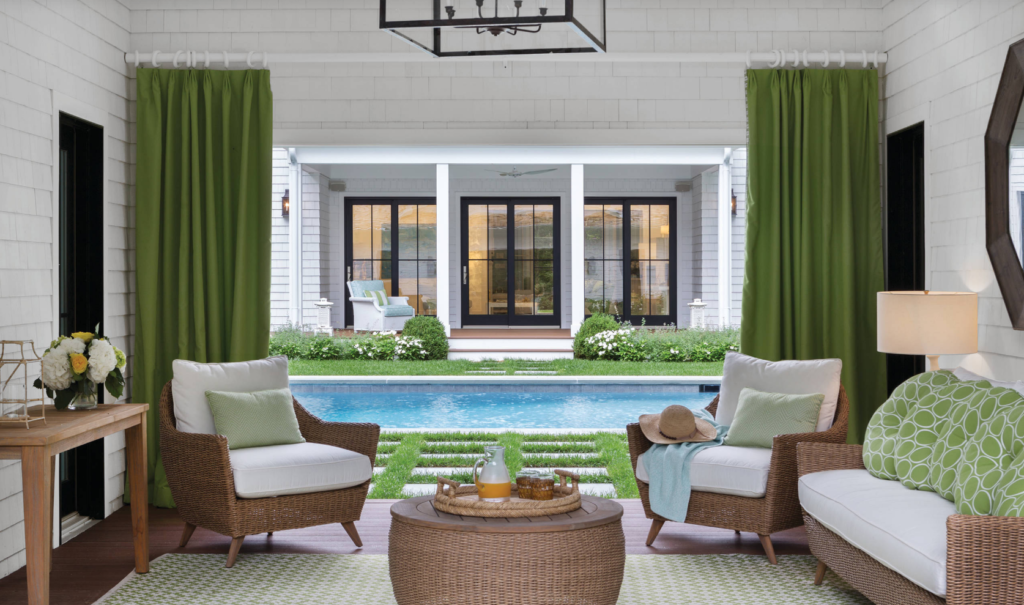
While covering patio doors is a great idea to provide privacy, what we shouldn’t end up with is a window dressing that fails the purpose of the patio doors – to connect us visually with the outdoors, to let light and air in, serve as an obstruction-free passageway and make the room feel spacious. And not all the window treatments that work well with ordinary windows and doors will work well for patio doors. It’s because the challenges with dressing patio doors are different from that of others. For your convenience, we have listed them.
- GRAND SCALE: Unlike windows and other doors in the house, patio doors usually have an overbearing size since they are specifically meant to connect the interior of the home with the exterior environment. And that in itself is a challenge as many window treatments fail to be sturdy and efficient when designed in large dimensions.
- METHOD OF OPERATION: Unlike windows, patio doors have a different style of operation. They may be single or double doors that swing open in one or both directions. Or, they may be sliding doors that move on a track and stack up on a side. Or, they may be bi-fold doors with multiple panels connected with hinged frames that fold against the wall like a concertina. The choice of window treatment will largely depend on how your doors operate.
- TYPE OF DOOR: You’ll have to factor in the making of the door, especially if you’re thinking of mounting the treatments directly onto the doors. Are they French doors or framed glass panes that offer a surface to affix a window dressing? Or, are they half-glass doors that require very minimal coverage? Or, are they frameless glass panes that might necessitate mounting the treatments on the walls instead?
- STACKING ROOM: For wall-mounted treatments, calculate whether there is sufficient space for stacking room on the wall enveloping the doors. If there is space above, you can mount shades and blinds. If there is space on the sides, think of curtains or sliding panels. If there’s no space either on the top or the sides, consider mounting on the doors or go for treatments with sleek profiles that need minimal space for mounting as well as stacking. In the end, whatever you decide, decide with an awareness that some of your door space will be blocked by the stacked dressings if you don’t have ample space on the walls.
- EASE OF CLEARANCE: Besides considering the space to mount the treatment, how they will fare with the usage of the doors should also be factored in. To pass through the doors, you’ll have to first clear the window dressing to the appropriate level. Careful consideration is advised therefore. For example, if the door swings inward and you have installed shades, you’ll have to raise them fully off the door’s frames to operate the doors. Similarly, curtains will have to be stacked back at the appropriate level to allow passage. Most clients may find it easier to draw side-stacking treatments for passage than top-mounted ones.
- KEEP HANDLES FREE: Close in hand to the previous point, is another one regarding access to the door handles/hardware. The window treatments must not ideally infringe on the handles, making it inconvenient to reach out to them for use.
- SET CLEAR GOALS: Define clearly the purpose of the window treatment so you can narrow down the options to those which tick the right boxes. Are you looking for highly functional window treatments to curtail light or provide privacy or more insulation for the cold months? Or, are you looking for decorative treatments to add a layer of color and pattern to your design scheme and stop at that?
- LIGHT CONTROL NEEDS: If your prime concern is light control, go one step ahead and define the level of control you’re seeking. Do you want a treatment that filters in light softly or one which blocks the light fully? Or, do you want to go a step further and ensure room darkening to enjoy your movie time?
- PRIVACY NEEDS: If privacy assurance is the goal, define it with more clarity. If it’s for daytime privacy then semi-transparent treatments can do the job. If it’s for privacy during the night, you might need blackout or at least fully lined treatments.
- CLEARANCE FOR MAXIMUM VIEW: No matter what type of treatment you go for, you certainly don’t want them to be so obtrusive and bulky that you can’t enjoy the views when you wish to. They must clear the windows to the maximum level when not in use.
- HIGH QUALITY MATERIALS & HARDWARE: Oversized window treatments require high-quality hardware to anchor the treatment strongly. Additionally, the material has to be hardy because it will be constantly exposed to the sun and the winds. Fabric treatments should be lined suitably to ensure longevity.
- STYLING DECISIONS: Since patio doors make you anticipate the landscapes or cityscapes beyond, honing that flow with a suitable palette, pattern, and structure can add to the vibe of the space. The window treatments should ideally connect the mind to the outdoors. So, earthy hues, wood textures, floral and botanical patterns, and organic and free-flowing profiles would work really well for window treatments for patio doors.
- DECOR STYLE: Last, but never least, don’t lose sight of your aesthetic goals in the process of selecting the relevant window treatments. Your patio door window treatments must definitely be a statement of your personal decor style since they occupy such vast optical real estate.
First Things First: Sort the Key Decision Regarding the Mounting Position
While there are several parameters to consider as we just saw, the most decisive one is regarding the mounting position. It is because this decision has much to do with the practical ease of operation that you are looking for. Since patios are highly frequented areas of the home, it is important to have treatments that work best for your space.
Patio door treatments come in various types based on how they are mounted. Once you tackle the important decision regarding their mounting position, you’ll have the options narrowed down a great deal to make your selection process fast and easy.
You can either go for window treatments that stack vertically on the top (blinds for example) or for those that stack to the sides, like drapes. Have a look at what you gain or lose with the various options.
Top Mounting vs Side-Stacking: Which is the Best for Your Patio Doors?
Side-Stacking Treatments
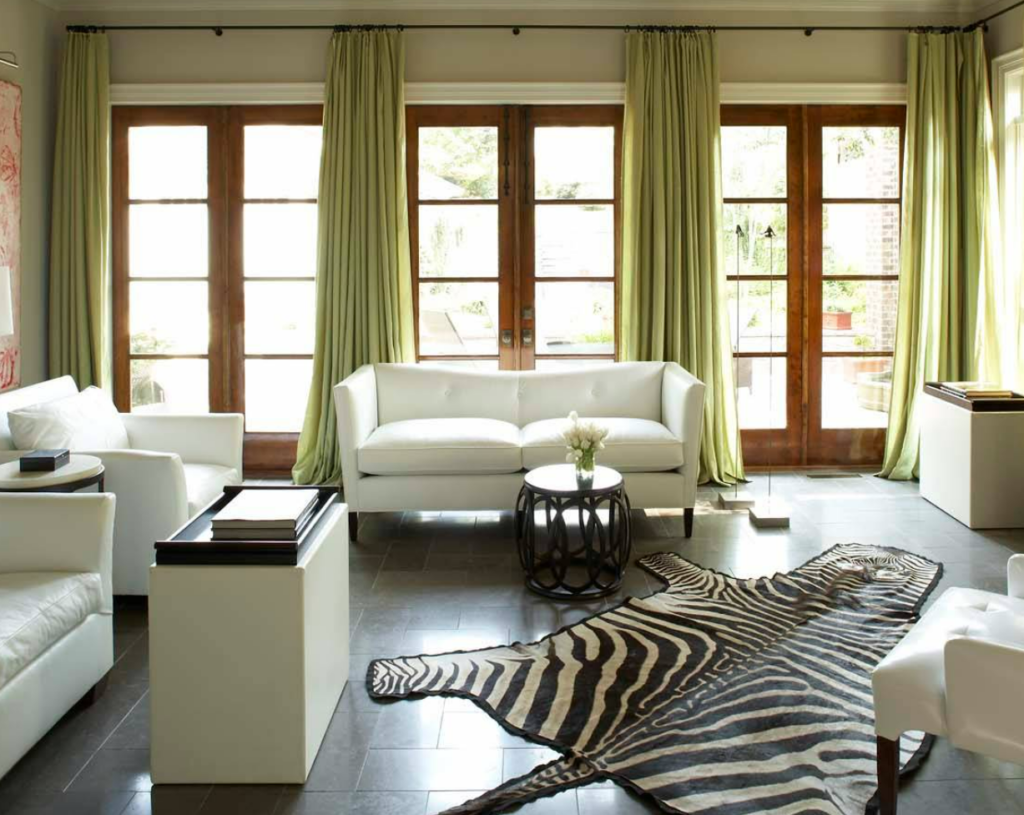
This includes all window treatments that can be folded or gathered to the sides of the doors, to clear off horizontally. Curtains, drapes, vertically-slatted venetian blinds, panel track blinds, and vertical cellular shades are some examples.
ADVANTAGES OF SIDE STACKING TREATMENTS
Since doors operate horizontally, window treatments that clear off horizontally look better aligned and more convenient for use. We list all the wish-worthy features of this option here below:
- Top-stacking shades or blinds get tucked away above head level when fully closed and stop at feet level when fully opened. But, side-stacking treatments are readily accessible all the time. You don’t need to grope for the cord or bend to catch hold of the shade’s handle. Whether you intend to open or close the treatments, their availability at hand’s reach adds to the practical convenience of usage.
- If your window treatments are closed and you need to access the doors, a little maneuvering is enough to allow passage.
- These treatments solve the problem if there is no place on the top for mounting.
- Some clients look towards dressing the sides and softening the trims of the doorway. Arguably, it is only through some of the side-stacking treatments that it can be achieved.
- Most of these treatments will be always visible, even when not in use and stacked on the sides. Hence, you can seize the opportunity and double them up as decorative additions with the right kind of styling.
- If mounted correctly, side-stacking treatments will clear the doors fully when closed. There are also treatments that make very sleek stacks when gathered to the sides.
DISADVANTAGES OF SIDE STACKING TREATMENTS
Now let’s draw your attention to some of the reasons why you may not want side-stacking treatments:
- Since these treatments are well within reach, they can become a sport for kids and pets.
- You might have to commit some wall space and floor space for these treatments, and if the room is small, this can be challenging.
- Some homeowners, especially those who lean on minimalism, may not like that the window treatments are visible when they are not in use.
Top Stacking Treatments
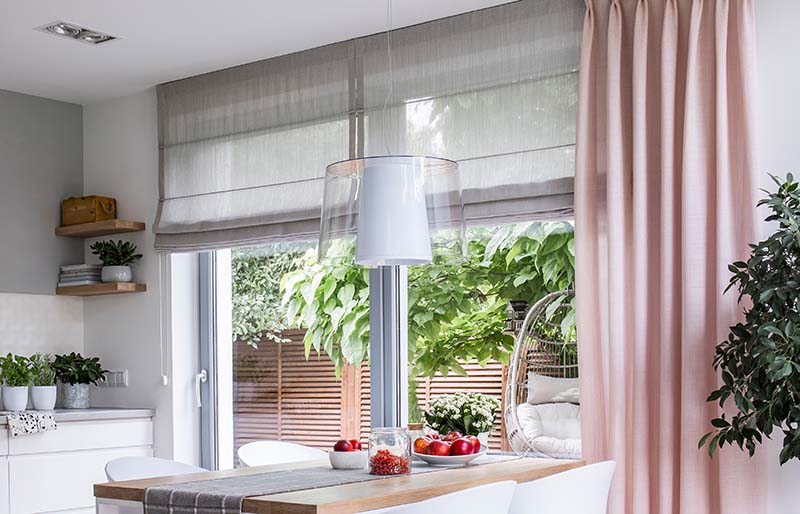
In this category, we have all the window treatments that are mounted and stacked above the window. These include shades and blinds of all kinds, either folding or rolling upward and downward when operated.
ADVANTAGES OF TOP STACKING TREATMENTS
And these are the reasons why some prefer them:
- Top-mounted window treatments clear the wall when drawn upward. And, even when in use, they are usually very sleek and ruffleless. Hence if you are looking to push furniture or huge plants close to the doors, these space-saving treatments can be relieving to have.
- They solve the problem when you ideally want your dressings to completely clear the doors when stacked, and but don’t have any wall space on the sides of the doors for the stacking room.
- If you have kids and pets, you can rest easy that the window treatments will not be accessible to them, except when they are drawn down. Most shades and blinds come with child safety anchors so the cord won’t be accessible for them. For further safety and convenience, you can even motorize them.
- These treatments clear the doors fully when closed if you mount them high enough. Or, you can choose from among treatments that come with a sleek profile.
DISADVANTAGES OF TOP STACKING TREATMENTS
Top-mounting treatments don’t come without any downsides of their own. And if you want to be cautious, here they are:
- The very fact that the treatments open vertically while the doors open horizontally makes for some inconvenience. If you want to pass through doors that swing inwards to open, when the shades/blinds are down, you’ll have to first clear it all the way up before you can pass through. Whereas, with horizontal treatments, you can slide through easily by making a slim gap. If the doors swing outwards or are sliders, the solution to the problem is to keep the shade partially open so you can maneuver and make your way, but then the lower half will be left open which can be bothersome if you’re aiming for light control. Or, go for multiple panels and you can keep one panel open for accessing the doors while all others can remain shut for privacy and light control.
- Top-mounted treatments are only anchored to the wall on the top. Since the scale involved is huge for patio door treatments, they can become clumsy to operate due to the weight and volume. The solution is to select lightweight to medium-weight options, install multiple panels instead of a sweeping one, or motorize them.
- While minimalists might like the idea of window treatments that disappear when not in use, maximalists may feel they add nothing to the aesthetic diversity of the space. This is true of all the top-mounted treatments that get wounded within sleek cassettes, leaving no sign of their existence.
A Word on Door-Mounted Window Treatments
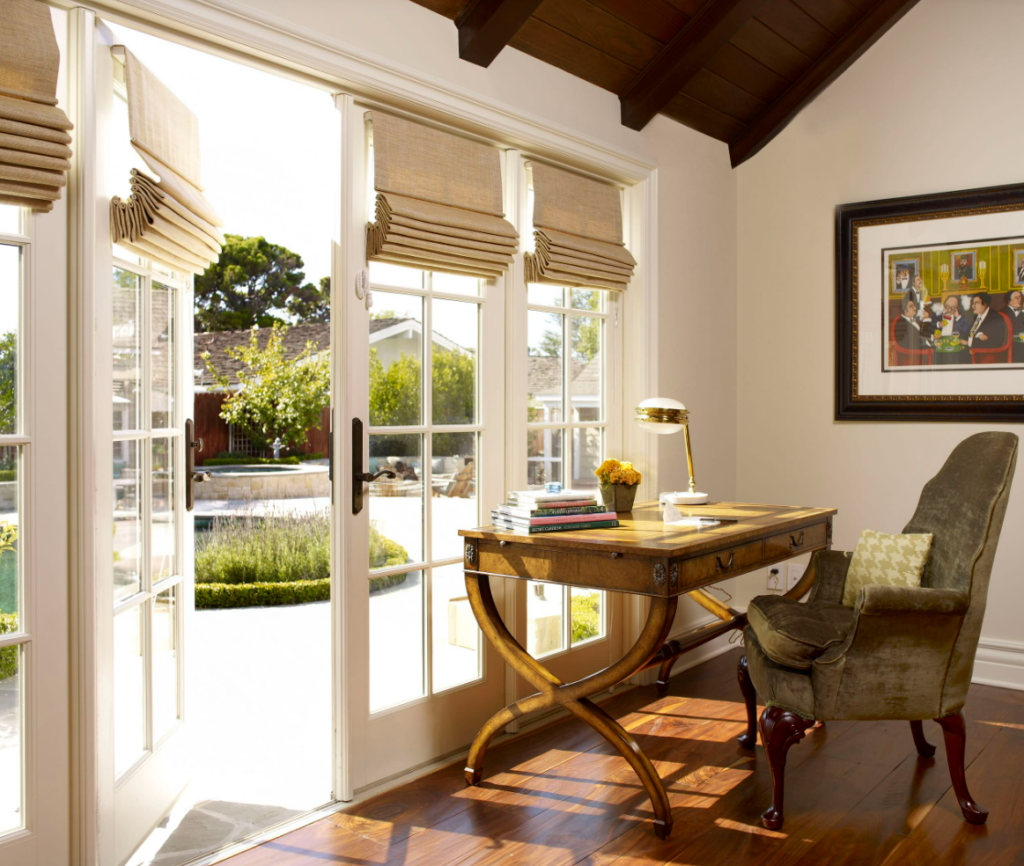
Most of the window treatments in both categories may be mounted on the doors. It works best for settings where there is no room on the sides or top to stack the dressings without hindering the operation of the door. Doors with deeply recessed frames can have the treatments mounted within the recess. For others, as is the case with french doors, they can be mounted on the frames.
Whether the treatments are mounted on the walls or the doors, remember that the pros and cons of top-stacking and side-stacking are still relevant. The most praiseworthy pro specific to door-mounting is that the window treatments do not obstruct accessibility to the doors. And, the downside is that they block some of the view and the light permanently, unless they are ultra-sleek.
Our Top Recommendations for Window Treatments for Patio Doors
After you’ve made up your mind on which type of mounting suits your patio doors the best, you’ll find yourself in a better position to research for the right one within that category of window treatments. Hence, we have grouped our recommendations under two heads for your convenience.
Side-Stacking Window Treatments
The window treatments in this category operate horizontally and stack on the sides. We have shown our degree of preference in the order of their numbering. And, right on top of this list is our all-time favorite dressing – drapes & curtains.
Drapes
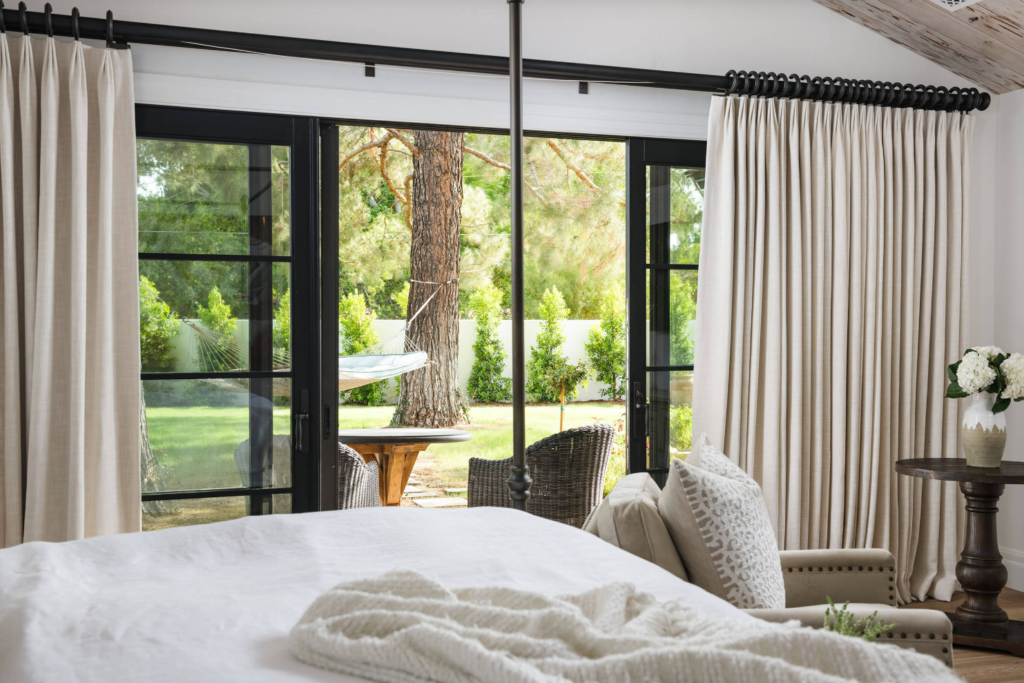
Tried-and-true treatments have worked great for millions of homes down the centuries. But our highest applause goes to curtains and draperies not just because they proved their caliber in history but also because none other marries functionality to elegance this well – especially when it comes to doors. And many more reasons abound –
- MATCHING THE SCALES: When selecting window treatments for any space, matching them to the scale of the space is imperative. Since patio doors are generally oversized, drapes and curtains are almost a default choice as they engage more fabric. And, their luxe rippled contour billowing with the winds rhymes with the organic beauty of the scenic views they frame.
- HUGE STYLING POTENTIAL: Since the base material is fabric, the styling potential is blown to the skies as they can don any weave, pattern, color, or texture that you love to introduce to your patio doors. Added to that, you can style the hardware, trimmings, and accessories to suit your aesthetic goals with precision. No matter what design style you follow, it’s easy to find options that voice them eloquently.
- LIGHT CONTROL OPTIONS: Besides the aesthetic potential, the functional diversity of fabrics lends you the perfect spectrum of choice within a category of window treatment. You can get gauzy viscose, loose-woven linen, lace cotton, heavyweight cotton, linen, and blends, thick-woven plush velvets, and room-darkening blackouts – to meet all types of light control requirements.
- SATISFIES INSULATION REQUIREMENTS: In case your patio is attached to your en suite, you might also be looking for insulative window treatments. And again, drapes beat all other treatments since their voluminous use of fabric makes them the most insulative of all treatments. However, you also need to choose the right type of fabric, heading style, and lining and mount them correctly to achieve the goal.
- EASY OPERABILITY: No matter how heavy your drapery can get to be, the hardware can easily manage the weight whereas some other treatments can be cumbersome to operate when designed in huge dimensions. And, if you expect to operate your drapes ever so often, consider investing in traverse rods or motorized rods. Or, choose a heading style that incorporates rings, clips, or grommets so the drapes may glide easily on the rods/tracks.
- DESIGN STRATEGY FOR HIGH-TRAFFIC ZONE: While draperies are stylish, homely, and highly customizable, you may mind their flowing and billowing trails in high-traffic patio doorways. Size them carefully to stop an inch above the floor, use drapery weights to control the fluttering, and invest in suitable tiebacks so that they stay out of your way.
- SEASH CURTAINS: In case you love the softness of drapes but prefer to avoid their elaborateness, you can go for their minimalistic version. The door-mounted double-rod pocket curtains sit in perfect-fit position over the glazed section of your doors, making them perfect suitors for French doors, half-glass doors, and framed glass doors. The curtains sit taut between two sash rods and can be slid sideward to let light in. Sash curtains suit casual traditional decor styles with country leanings.
Curtains and drapes can be designed to suit any decor style and any type of light control requirements. Easily, their custom look is what gets most people sold on them. And even if you have shades or blinds on your patio currently, you can use curtains as an overtreatment to soften the space. But, if you love curtains for the way they function but want a pleat-less option, consider the next recommendation.
READ MORE: PATIO GLASS DOOR CURTAINS: IDEAS & TIPS
Sliding Panel Tracks
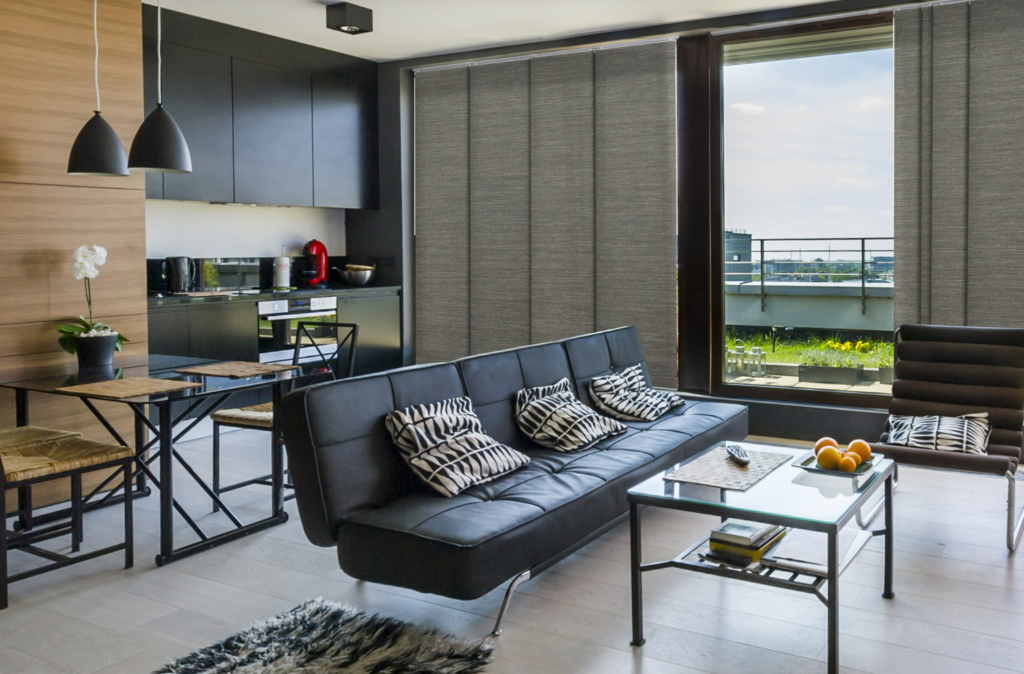
Operating on a track system, multiple panels made of fabric, plastic, or wood slide across the whole span of the doors to cover and uncover the doorway. These panels can be stacked to a side or in the middle when you want to let air and light in. The material can be sheer or non-sheer, and the fabric panels can also be a blackout.
- SUITABILITY OF OPERATION: Since the style of operation is similar to that of the sliding glass doors, this window treatment is considered to be most suited for them. The doors and the panels can be stacked on the same side and so accessibility to the doors is not challenged.
- But as regards swinging doors, you can only access the doors after first sliding the panels away to the appropriate level. If you would use the window treatments rarely, this would not be a major issue, otherwise, it would be bothersome.
- COMPATIBLE DECOR STYLES: The sleek structure of the panels makes them better suitors for contemporary and transitional settings rather than traditional ones. However, it is possible to style them to fit any non-maximalist decor style by working on the details such as the material composition, texture, pattern, and palette.
- ASYMMETRY ISSUE: Unless designed to operate in opposite directions, panel blinds look asymmetrical as they gather towards one side. That imbalance can upturn the aesthetic balance of the whole space, especially if they feature patterns. But if this aspect is factored in when designing the space, the balance can be achieved.
- STACKING ROOM: Sliding panels do not clear the doorway completely. Their stacking room equals the width of a panel – the wider the panel, the more the stacking room. Some clients would mind sacrificing that much of the view, given that the purpose of patio doors is primarily to capitalize on those views. Besides, if your door opens inward, the stacks won’t allow you to operate the doors.
Although functional and elegant, panel track blinds are bothersome for those who mind them encroaching on the doorway. So, you can consider the next option which will not ask for a huge compromise in this aspect.
Vertical Blinds
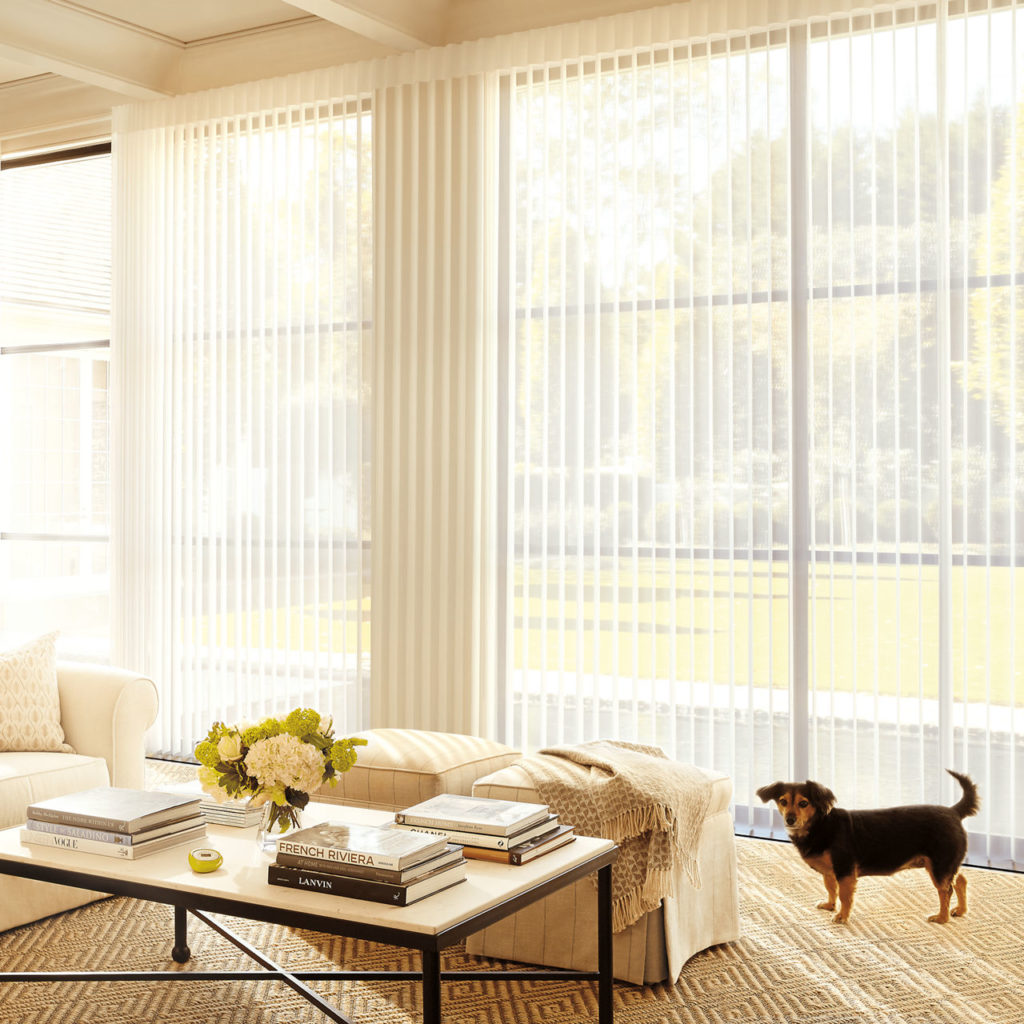
One of the most common patio door treatments, vertical blinds are made up of several vertical slats that are attached to a track at the top of the window. They may be made of vinyl, fabric, wood, or metal. When they are turned flat, each slat overlaps the previous one and covers the entire doorway without a gap.
- SWIVELING SLATS: The highlight feature of this treatment is the swiveling of the slats which facilitates great control over privacy and light control. Depending on the direction of the sunlight, you can rotate the slats to let more or less light in.
- MINIMUM STACKING ROOM: Since the slats are very sleek and they swivel to right angles when they stack, they take very minimal space. Thus, you don’t have to compromise the good views or the light.
- ECONOMICAL: As compared to most other window treatments, vertical blinds are lighter on your pockets. If you’re decorating your home on a budget, these can be your go-to.
- NOT A HEADTURNER FOR SURE: While vertical blinds get the job done, what they don’t provide is the elegance and styling potential that most homeowners look for. In fact, they look very industrial and liken the space to an office room rather than a fun-packed relaxing patio. Mostly available in solid neutrals, these blinds blend into the space but add nothing to its aesthetic diversity.
If louvered treatments have piqued your heart but you want more sturdy alternatives, go for the next.
Plantation Shutters
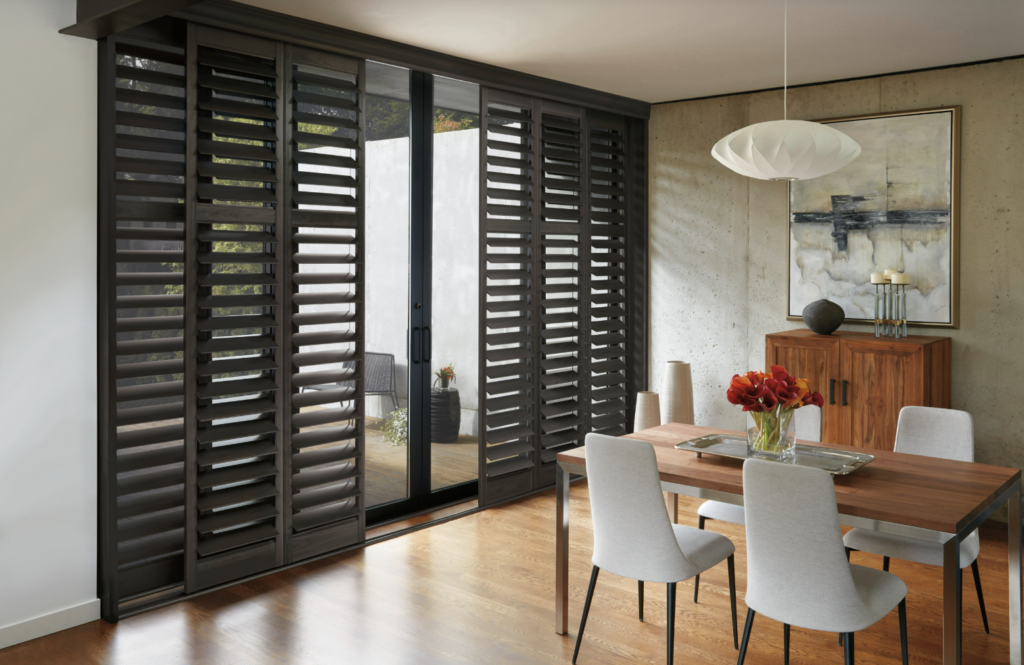
These wooden louvered window treatments affect the facade of the house as much as the interiors. And certainly, that makes them a solution for ‘forever’ homes and not temporary rentals. Either made of wood or faux wood, plantation shutters feature horizontal slats that swivel on their axis. They can be designed as sliding panels or as bifold doors, making them suitable for all kinds of patio doors.
- SWIVELING SLATS: Easily the plus point of all louvered treatments, shutters allow great control over light and privacy. You can adjust the angles of the slats according to the direction of the light.
- HYPES RESALE VALUE: Since shutters are custom treatments that are an addition to the architecture, there’s no better way to design doors and windows to step up the resale value of the house. These are structural renovations with high returns that also add to the aesthetic appeal. To know more about how assets and upgrades can affect your home resale value, read our blog on ‘The Return on Renovation: How Upgrades Impact Home Value‘.
- COMPATABILITY WITH DECOR; Since shutters are an age-old treatment found in traditional homes, coastal cottages, or beach houses, they still carry the same vibe. They may not be the most perfect window treatment for most other design styles.
- COMPROMISED VIEW: While shutters help the building to achieve a uniform look on its exterior, they brutally cut off the light and the views that you so wish to enjoy through your patio doors. You can only let light gush in if you clear the shutters fully off the doors.
- LIMITED STYLING OPYIONS: Beyond customizing the size of the slats and the number of panels, this window treatment will not let your imagination and design skill fly high. With very limited ability to bring in color, they miserably fall short of impressing color-driven design styles.
If you’re looking for a sleek window treatment that is suitable to contemporary styles of architecture and design, our next recommendation might interest you.
Cellular Blinds
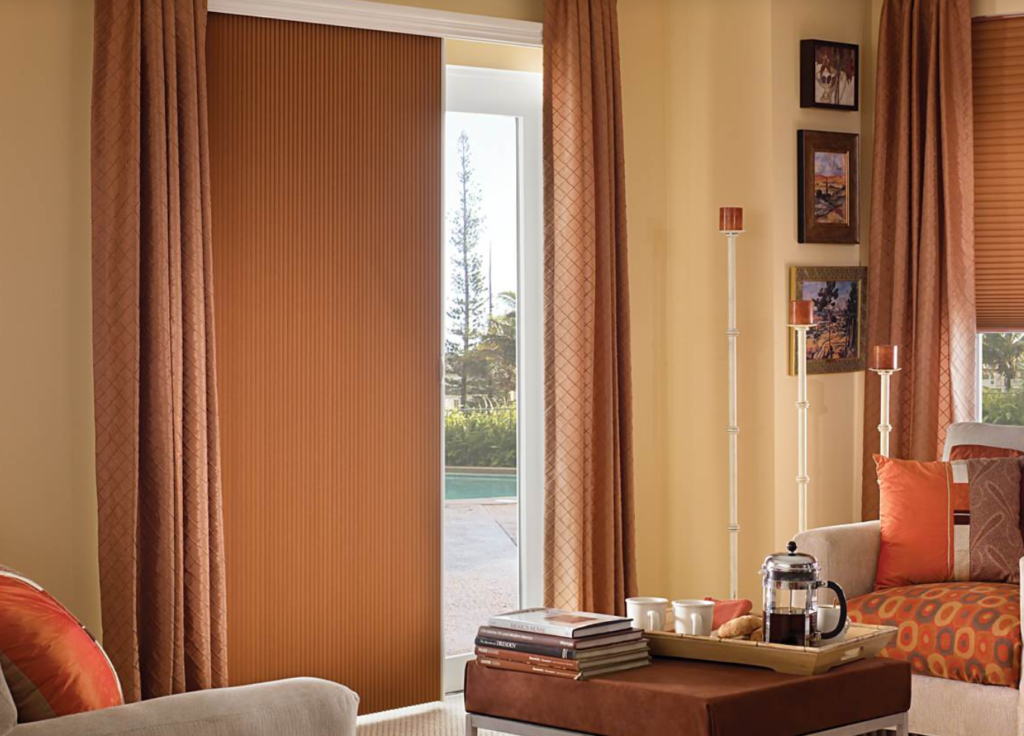
Made of polyester, these blinds are specially designed to meet the needs of homes that need high insulation. Made in double layers that are attached together by a pleated layer in between, these blinds have a series of small pockets which look like honeycomb cells from the sides. That explains their second name – honeycomb shades. These cells trap air, creating a heavily insulated layer between the exterior and interior environment, keeping the space cool during summer and warm during winter. They may be designed with sheer, non-sheer, or blackout fabric to suit the diverse needs of clients.
- TEMPERATURE CONTROL: Since patio doors are oversized and their glass panels leak thermal energy, cellular shades are a wise option to retain the temperature of the room. If your patios are attached to bedrooms and nurseries, this window treatment might help you create a more sleep-friendly ambiance.
- EASY FUNCTIONALITY: The best feature of this window treatment is its functional ease. Cellular shades may be vertical or horizontal, and accordingly, they may be stacked to the top or the sides. Horizontal shades’ highlight is their top-down/bottom-up feature which allows you to open the shades both at the top and the bottom. Vertical cellular shades, on the other hand, are desirable for their ultra-thin stack that almost disappears into the architecture. Both versions are easily accessible and complement the functionality of all types of patio doors very well.
- MINIMALISTIC DESIGN: Cellular shades are very minimally designed and come in solid neutral hues, making their rippled contour bring textural variety to the space as it interprets light with shadows. Other than that, they add little to build up an aesthetically elevated space. Homeowners with maximalist leanings might find them to be too unimaginative for their style.
Top Stacking Recommendations
If you have decided to go for minimalistic treatments for your patio doors, top-stacking treatments will not disappoint you. These treatments may be mounted on the wall above the doors or on the doors themselves. We have three recommendations for you, each unique in its own way and capable of satisfying varied tastes.
Fabric Roman Shades
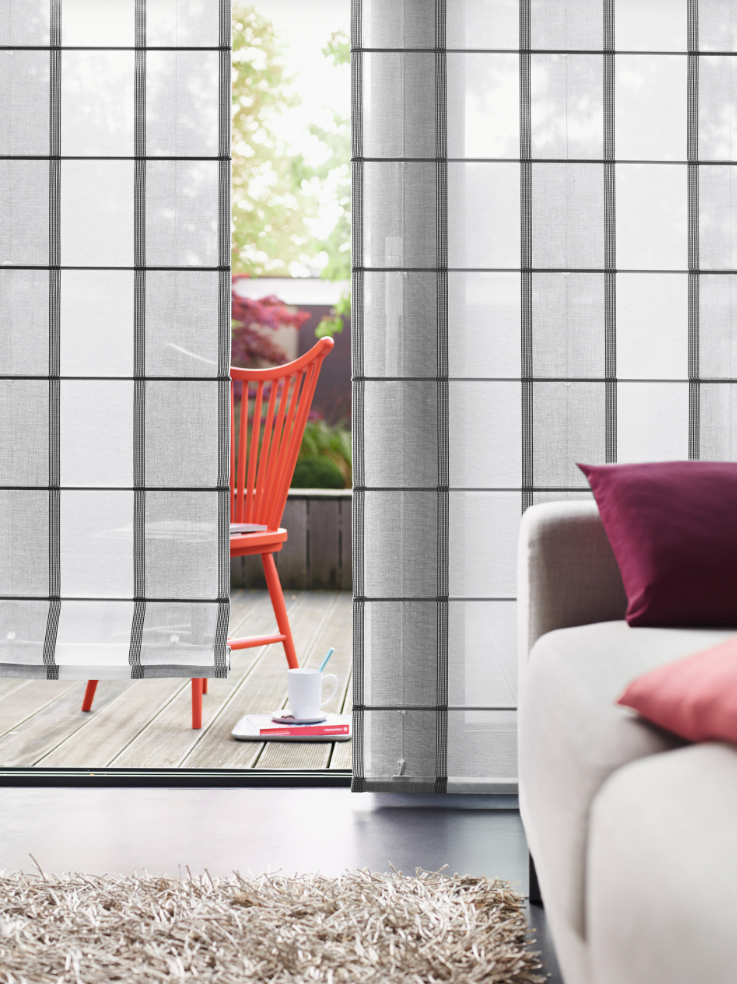
For the love of all things good about fabrics, roman shades are on top of the list. They are single fabric panels that fold in accordion style upward on a cord and loop system. If your patio has multiple doors, installing one shade above each door would be ideal. We love roman shades on patio doors because:
- GOODNESS OF FABRICS: Roman shades are sleek, modern, and yet more luxurious in appeal than most industrial blinds. Like drapes, they bring softness to the space but without being too elaborate or space-consuming. And they are highly customizable given that fabrics can come in all sorts of weaves, textures, colors, and patterns. You can design them as light-filtering, light-blocking, or room-darkening.
- COMPATIBILITY WITH DECOR STYLES: Roman shades can speak any design language because you can work your preferences into the details. While their structure is minimalistic, the fabrics can bring in the vibe you are looking for, be it traditional, country, eclectic, modern, industrial, or even a melange of many styles. This is done by making the right choice of fabric, palette, pattern, style, and accessories.
- ACCESSORIZING TO ADD CHARACTER: Unlike any of the other blinds and shades, roman shades can be beautifully zhuzhed up with suitable trimmings. You can choose from a whole galore of trims such as tassels, fringes, baubles, pompoms, ribbons, gimps, braids, and so on. These dainty details can load the space with a unique personality. Trims that ornament the lead edges quiver with the passing winds, making them a moment of cheer on your patio and syncing with the organic beauty of the outdoors.
- HANDMADE: While shades and blinds are generally produced industrially, made-to-measure roman blinds are the result of dexterous craftsmanship and labor. Whether it be the stitching of the shade or the trims that you dot them with, human touch is central to their making which makes them an incredibly beautiful and valuable addition to your patio doors.
- DOUBLES UP AS A VALANCE: This is another feature that makes roman shades our top favorite among shades and blinds. The stylish folds of the shade dress up the top of the patio doors like a valance. So, even when the shades are not being used, they work hard to add style and beauty to define the ambiance. If your patio is an extension of your living room, count on roman shades to be great decor accessories to amp up the space with style.
- FUNCTIONALITY: Roman shades come in three popular styles. The ones which employ slats are ideal as they make crisp and even folds. Whatever type of door you have, you can mount multiple shades on the wall above. Keep one shade above head level in high traffic time periods for easy passage while all others can remain shut for light control and privacy. If the recess for the patio doors is deep, mount the shades on the ceiling of the door frame. This will take a few inches of the top portion of doors as a stacking room but will not hinder passage in any way.
While roman shades are stylish additions to the patio, some may mind that they take up stacking space. If you’re looking for options that disappear from the scene when they are not needed, the next option should meet your needs.
READ MORE: ROMAN SHADES FOR DOORS
Roller Shades
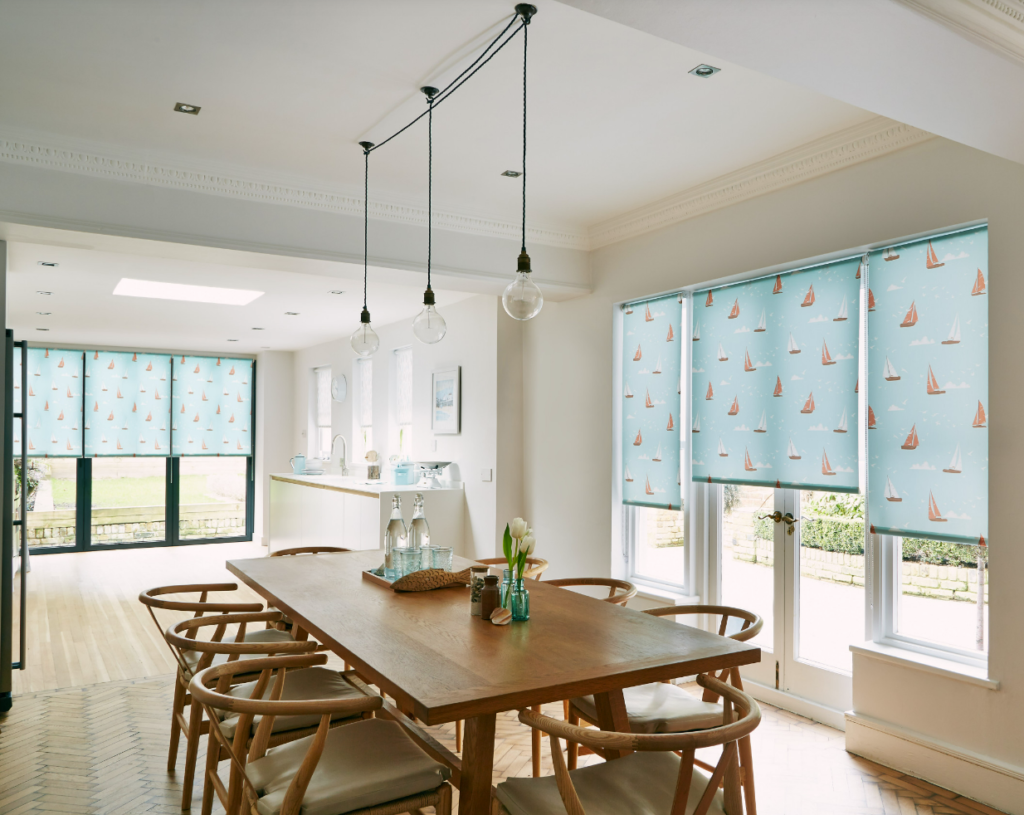
Made of a wide variety of materials from natural fabric and wood to synthetic ones like polyester and vinyl, roller shades are the sleekest window dressings for patio doors. They are single-panel coverings that are wound upon a rod hidden inside a sleek cassette. Operating on a spring or motor mechanism, they roll out like scrolls to cover the doors and roll up to fit into the cassette.
- ZERO STACKING ROOM: The most striking feature of roller shades is their sleek build and svelte cassette which comes in handy for patio doors that lack space on the top and the sides for mounting any window treatment.
- WIDE VARIETY: Roller shades are an umbrella term that refers to the operation technique of the shades. They come in wide varieties such as solar shades, zebra shades, vignette shades, silhouette shades, blackout shades, outdoor shades, and so on. You can always find one that suits your purpose.
- MODERN MINIMALISTIC LOOK: The sleek and function-oriented making of roller shades makes them suitable for modern minimalists. If you want functional accessories that blend into the space rather than stand out and add vibrance, roller shades are perfect, especially when designed in solid neutral hues.
- COMPATIBILITY WITH DECOR STYLES: Despite the wide range of colors and patterns that roller shades come in, the choice spectrum is nowhere close to that of fabric shades. Thus, their ability to sync with specific design styles and color palettes is challenged. Roller shades are largely incompatible with maximalist styles unless you can make up for their minimal silhouette by layering them with other soft and pizzazzy treatments.
While roller shades are smart and sleek and suitable for modern homes, patios may be calling for window treatments with a touch of nature. Hence we bring you our next recommendation.
Woven Wooden Shades
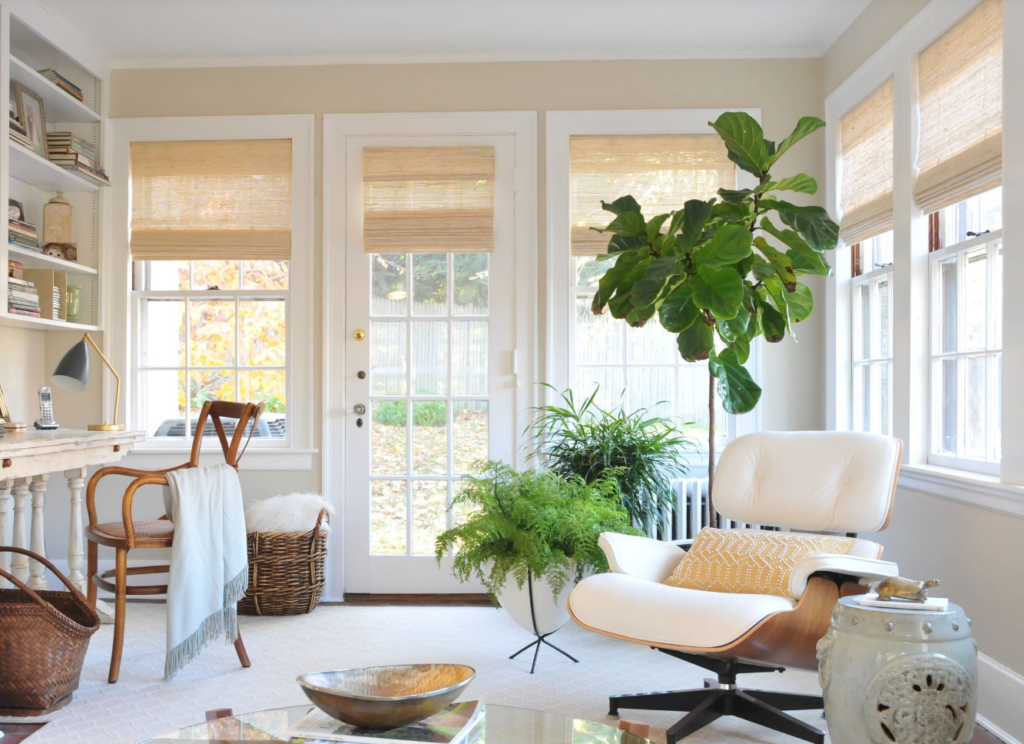
Patios made of wooden pallets or decked with potted plants may be framed fittingly with woven wooden shades that make the mind anticipate what’s beyond the patio doors. Woven wooden shades may be made of wood, faux wood, grass, jute, and the like and operate on rollers like roller shades. You can determine the level of sheerness and some wooden blinds even come with liners to provide more control over light inflow.
- ORGANIC APPEAL: Hands-down, woven wooden shades get all the points for their rustic/organic vintage feel. They pair well with the solid wood furnishings in the space and make a beautiful contrast with light-colored walls. If you are looking for decor accessories that can take your home back to the countryside of olden times without losing the modern touch, look no further.
- COMPATIBILITY WITH DECOR STYLES: Precisely because woven wooden shades suit more traditional rustic decor styles, they are not in line with modern and contemporary styles. So, no matter how much you may love them, if your architecture and design language does not vibe with them, they may be better overlooked.
A Note on Decorative Window Treatments for Patio Doors
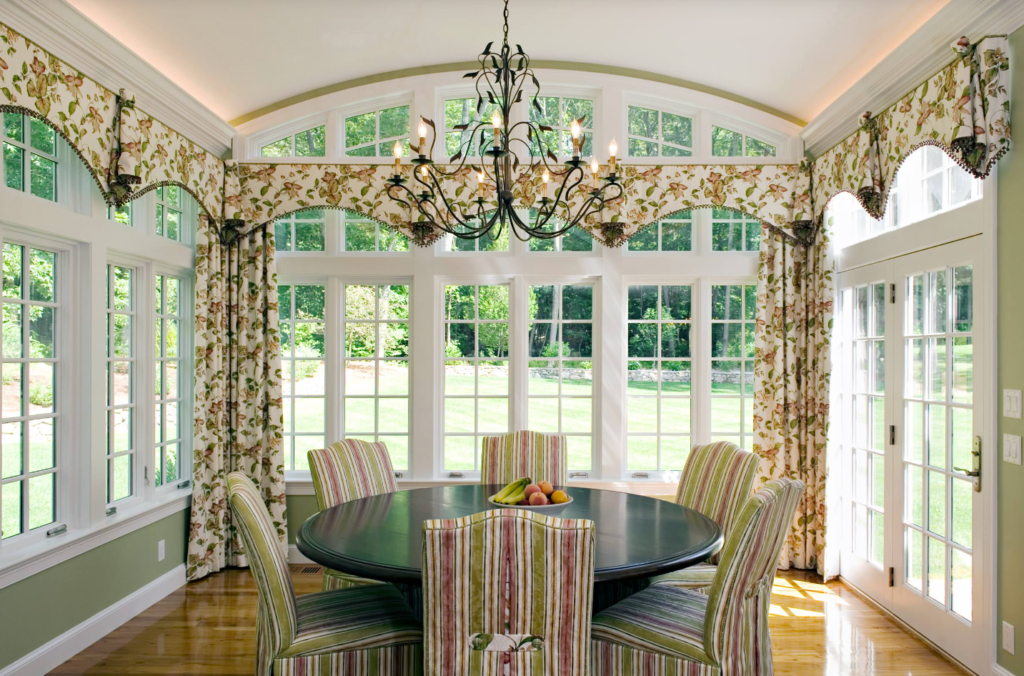
Sometimes, patio entryways are not in need of light control as much as a touch of color and glamour. Perhaps you have just finishing decorating a stylish outdoor space for entertaining in summer and you doubt’ want to close off the view. You may not want to cover your beautiful glazed doors and windows with any dressing and yet hate to leave them bare as they may come across as a forgotten chapter of your interior design. Besides, without a layer of color and pattern, the space may look too boring and unimaginative. Hence, for such patios, we suggest going for decorative window treatments. These work as decor accessories but neither block the views or light nor provide privacy.
You can go for decorative window treatments instead of functional window treatments when:
- You’re convinced of the aesthetic potential of window treatments and are not in need of their functional aspects at all. You’re neither looking for privacy, nor light control but want to coordinate patio treatments with the overall decor of the home. Especially if you have dressed-up windows in the same space, patio doors being left untreated looks like a faux pas rather than an intentional decision. Having decorative treatments made of the same material helps to build cohesiveness into the design
- Decorative treatments are highly recommended for those who cannot afford functional treatments. Later, when the financial constraints have been managed, elaborate functional treatments can be layered in.
- When there are architectural flaws that need to be addressed even though light control or privacy is not an issue, decorative treatments can camouflage them. For example, uneven trims or unpleasant bulkheads ruin the excellent design of the rest of the space.
If these issues are relatable to you, consider the following options:
- VALANCES: These fabric mini curtains dress the top fourth of the doors, softening the top trims with a decorative touch. They can be styled in various ways to suit your specific decor style – with frilly pleats for traditional spaces and flat contours for modern spaces. Valances can also be used as decorative toppings over curtains, drapes, shades, and blinds.
- FAUX ROMAN SHADES: These are miniature fabric roman shades that have their folds secured by stitches. Faux roman shades look like fully functional roman shades but in effect can only hang as stationary decorative fabric panels. Those who like the look of the roman shades but don’t actually need them for functional purposes can explore this option. If your doors open inward, hang the valance high enough to stay out of their way when they are operated.
- DECORATIVE DRAPES: Drapes don’t always have to be overbearing. You can use narrow drapery panels hung on small drapery rods to frame the patio doors. They will soften the side trims, add a dreamy layer of color or pattern, and dress your doors without overdoing the good thing.
- RELAXED ROMAN SHADES: This is a fully functional fabric roman shade that has stylish folds and scalloped bottom. Relaxed roman shades bring a sense of softness and luxury when they crown the patio doors. Their free-flowing swag bottom rhymes with the organic vibe of the exterior space. Additionally, if you ever need to control light or create a privacy guard, you can pull down these shades. Remember that you’ll have to lift the entire shade up before you can operate the doors if they open inward.
SHOP NOW: CUSTOM WINDOW VALANCES & SWAGS FROM SPIFFY SPOOLS
Concluding the Expedition
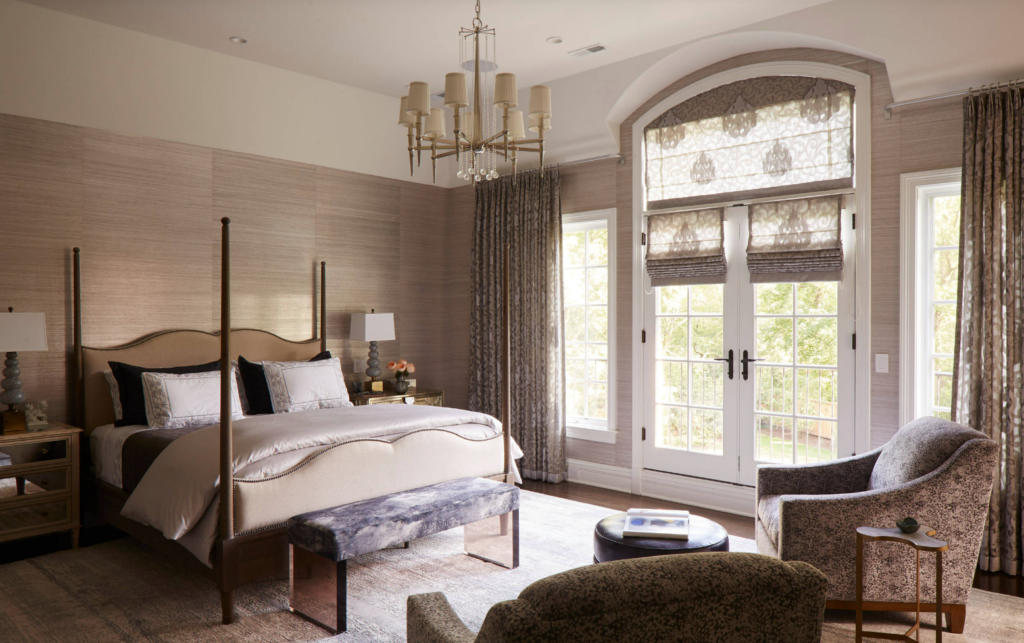
At the end of the long journey, we hope you have found a comprehensive guide for selecting the right window treatment for your patio doors. With so many alternatives at hand, the decision-making task can get very overwhelming, but with expert advice guarding your steps, you are sure to reach your destination. If your heart is set on any of the fabric treatments, count on Spiffy Spools to convert the window dressing of your dreams into a reality. And, if you have any queries, find us just a call away.
READ MORE: WINDOW TREATMENTS FOR FRENCH DOORS: IDEAS, PHOTOS & TIPS

